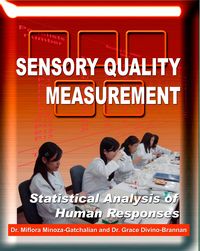- Sensory Quality Measurement
- Dr. Miflora Minoza Gatchalian and Dr. Grace Divino Brannan
- Publisher: Quality Partners Company, Ltd.
- ISBN: 978-971-691-921-9
- No. of Pages: 296
- Size: 6"X9"
- Edition: 2009
Description:
This book is intended to be practical and useful for all readers and potential users of the methodologies. At the same time, we hope that exposure to this book will inspire more people to become interested in the practical applications of sensory evaluation through an improved understanding of its concepts and applications. Although the authors realize that this is a modern age, we believe that there is still a basic need to understand statistical concepts, applications and their interpretation in the context of making judgements about sensory perceptions. For this reason, much of this book is dedicated to presenting statistical methods that provide an improved opportunity to appreciate the value of quality measurement. This is done by applying sensory evaluation methods to food and related products. We emphasize these measures must be properly collected, collated, statistically analyzed and interpreted. It is important to become adept at data interpretation so that conclusions can be derived at the highest level of objective confidence and at the lowest risk of committing errors of judgment. Statistical literacy is a most compelling capability in being able to evaluate perceptions regarding food quality.





